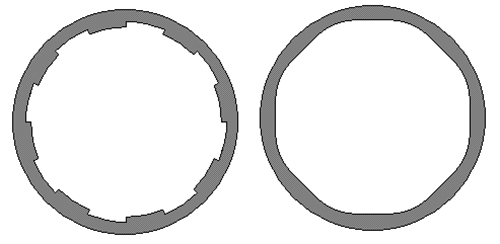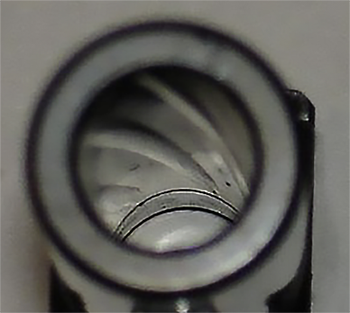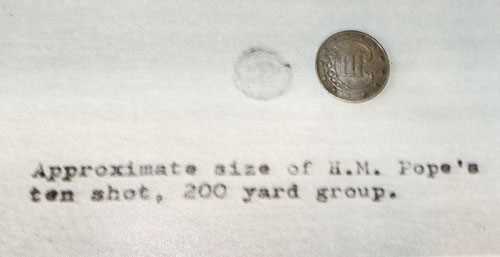
Conventional land-and-groove rifling on the left and polygonal rifling on the right.
This report covers:
- Conventional rifling
- Polygonal rifling
- Excellent video
- Glock rifling
- Advantages of polygonal rifling
- Disadvantages of polygonal rifling
- Pope rifling
- Summary
I intended reporting the velocity of the Colt SAA pellet pistol today but before I started testing I read the comments to the first report and one of the them jumped out and grabbed me. Reader Roamin Greco said, “Respectfully, perhaps if you saw nothing, and pellets show no rifling marks, the barrel actually isn’t rifled and the packaging is incorrect?”
Today we will look at polygonal rifling and see why you usually cannot see the rifling marks. But first we need to understand what polygonal rifling is. And before that let’s understand conventional rifling.
Conventional rifling
Conventional rifling is a series of ridges called lands and valleys called grooves that run along the inside length of the barrel. They are laid out in a spiral with the lands cutting into and “grabbing” the bullet/pellet to impart a spin. The distance it takes to rotate the projectile once is called the twist rate and is usually stated in inches. A one in ten twist means the rifling turns the projectile one time for every ten inches it travels. It’s normally written as 1:10.
Polygonal rifling
Polygonal rifling does not use lands and grooves. Instead it uses a bore shape that is not quite round. It is a polygonal shape that is so slight it can be difficult to see. The non-round bore shape does “grab” the bullet/pellet but not like rifling. It’s more of a squeeze than the cutting of conventional rifling.
Polygonal rifling does leave small marks on the projectile but they are so slight they can be nearly impossible to see. They are just shiny spots.
Twist rate can be the same as with conventional rifling. And many airgun manufacturers and also airgun barrel manufacturers are experimenting with twist rates today.
Excellent video
I found a great video on You Tube that covers polygonal rifling, standard land-and-groove rifling and even one kind of FX impressed rifling. It’s focused on airgun barrels so it’s ideal for us. The video is 9 minutes long, but you don’t have to watch all of it to get the point.
Glock rifling
Many people say Glock rifling is polygonal but I disagree. I would call it modified conventional at best, because when you look down a Glock barrel you can see conventional lands. They have simply been rounded. That’s true of all generations of Glock barrels I’ve examined.

A look down a Glock barrel reveals that the rifling is not a polygon. There are conventional lands, though they have been rounded.
Advantages of polygonal rifling
Because there are no real friction-robbing lands in a true polygon-rifled barrel, the velocities you get are slightly higher. The FX Smooth Twist barrel also has this advantage. A modified barrel like you find in Glocks probably doesn’t have much of an advantage, if any.
Polygonal barrels are easier to clean, since there are no tight corners to catch the lead or jacket material. I would say this is also true of Glock barrels, and also the FX Smooth-Twist barrels shown in the film.
Disadvantages of polygonal rifling
It’s really hard to say this with certainty but some folks believe polygonal rifled barrels make a firearm or airgun less accurate. One thing is certain, though—polygonal rifling is less tolerant of differing velocities and projectile weights. There is a narrow range of both projectile velocities and weights that work well with barrels that are rifled polygonally.
Pope rifling
I have referred to Pope rifling many times in this blog over the years. His barrels are considered to be the finest hand-cut rifled barrels ever made and around the year 1900, Harry Pope shot ten .33-caliber lead bullets into a 0.2-inch group at 200 yards!

Yes, that is the trime next to what I believe is the smallest 200-yard 10-shot group ever shot from a conventional rifle. From, The Story of Pope’s Barrels.
This report is not the place to cover Pope rifling again. If you want to read about it read, The invention of rifling: Part 2.
Summary
Today we have examined the design and benefits of polygonal rifling. Now we know why I couldn’t see any rifling marks on the pellet that passed through the barrel of the Colt SAA pellet pistol!

B.B.
Thank you!
I always thought that polygonal barrels referred to the outside of the barrel. Duh.
Thanks again,
-Yogi
PS hopefully you will also show his test results between rifled and poly’d? Do you have any airguns that have a polygonal barrel?
Yogi,
Aside from the Colt SAA that caused me to write this report, I don’t think I have any other polygonally-rifled barrels. Several readers have FX rifles with Smooth Twist barrels but they are not really polygonal, though they do get slightly higher velocity from what I’ve heard.
BB
Tom,
So polygonal rifling had less friction allowing higher velocity given the same powerplant but at the cost of being more particular to the projectile and power being used. Which jives with the experience of those using slugs that a regulator is required to achieve accuracy. In that case I’ll stick to regular rifling since I am not in their use case for slugs at long range. I’m just a humble plinker content to shoot targets within 50 yards.
I’m not quite sure though why regular Glock barrels do not like reloads. Something to do with elevated pressures? In any case changing the barrel to regular rifled barrels seems to eliminate this problem
Siraniko
PS This Report Covers : Pope riofling (rifling)
Lead reloads, right? Maybe Glock rifling is “semi-polygonal”?
Siraniko,
Fixed it. Thanks.
From what a gunsmith told me Glocks don’t like reloads because the cartridge isn’t supported well enough at its base. Reloads use cartridges that have already stretched a little at their base and may be weaker there.
Some Glocks have been known to explode when fired with reloads. It’s called the “Glock Ka-Boom!” And it’s more common than it should be.
BB
FM experienced “Glock Ka-Boom” with his P1/P38 several years ago – while shooting reloads.
Basil,
I knew other guns did it as well but I don’t think I knew the P38 was susceptible.
BB
This happened after the pistol had been in FM’s hands about 50 years; it was manufactured in 1966, bought NOS about five years later. Probably 1000+ rounds have been put thru it, including WWII-era surplus German machine-pistol ammunition, which by the way required pulling the trigger twice for most of the rounds to make the primer detonate. Dumb FM shoulda known better and held on to that ammo for its historical/collectible value. Have read more than once that wartime-manufacture P38s, especially if manufactured after 1943, should be fired sparingly, preferably with lower-power ammunition because of questionable metallurgy quality and suspect labor skills, including potential worker sabotage during pistol assembly.
No further problems after a capable local gunsmith repaired the gun, but FM is playing it safe and using only fresh factory ammunition, preferably with bullets weighing no more than 115 gr.
BB & Basil
Years ago I too had a P1 (post war) aluminum receiver P38 blow its top with mid range reloads. Repaired, I sold it to a dealer after hearing that others had this happen and telling him about it. I have never heard of a war time steel receiver P38 having this happen.
Deck
BB & Basil
I don’t own a Glock and was unaware it didn’t like reloads. Lack of support to safely shoot stretched cases may be the reason P1 Walther P38’s don’t like reloads. Like the reliable Glock, Walther ‘s P1 served German police after the war and likely gave no problems with unfired 9mm Parabellum.
This is just speculation by me.
Deck
Tom,
If they named it that means it happens often enough that it is a known problem. Not quite sure about what your gunsmith told you. If true, then why does the problem seem to get resolved when the barrel is changed? Headspace?
Siraniko
Siraniko,
The cartridge head (where the primer is) is not supported enough by the Glock barrel. Aftermarket barrels like the Wolff I have on my Glock 43 support the cartridge more.
BB
Tom,
Thanks for the explanation.
Siraniko
Like Yogi, I do hope you show the test results of rifled barrels versus polygonal barrels. I have been quite curious about the poly barrels for some time. From what I am understanding, they seem to be quite picky. Perhaps this is why we are not seeing more of it.
They do seem to work well with “slugs” though. Of course, this does usually mean that the airgun is regulated and the shooter is using a very specific “slug”.
Do you really think they went to the expense of a poly barrel with that SAA replica?
Oops!
Section title
Disadvantaged (Disadvantages) of polygonal rifling
Summary – Second sentence
Now we know why I couldn’t see and (any) rifling marks…
RR,
Fixed them! Thanks.
There are so many keys on this keyboard and they won’t always cooperate like I want.
BB
RR,
I signed that as NN. I fixed it quick.
BB
It’s always nice to see one’s name in your reports. Thanks for the shout out.
BB,
Just a little bit on yesterday’s subject. I have been looking at Defense Innovation’s .50 revolver, thinking of getting one to play with. I have noticed that PA has a fairly good selection of ammunition for this type of gun and was wondering if you had considered any of this for the Sheridan? I am still with Yogi on trying out the practice darts. I am not sure of the power, but they may work well with the dartboard.
RR,
I really hadn’t. But I will look into it.
BB
Excuse my ignorance, but what are the barrels called that instead of round, the outside has sides?
I have heard of 5 sided, 6 sided, and 8 sided barrels. I always thought that they looked cool.
-Y
Yogi,
The most common shape is octagonal — 8-sided. Hexagonal (6-sided) is sometimes seen, but it’s not common. I’ve never heard of barrels with five sides.
BB
B.B. and Readership,
Two of the best articles/discussions about barrels i have found and bookmarked:
https://www.americanrifleman.org/content/popular-rifling-types-advantages-disadvantages/
https://www.practicalmachinist.com/forum/threads/what-is-the-reason-for-octagon-barrels.276181/
Not much is written in the historical record about barrel making by the gunsmiths that did it…i suspect it was the concept of Craft Secrets that caused that.
shootski
I’ve heard from customers that FX barrels do better with slightly larger head sizes. One might think that head diameter would be critical, too.
B.B.
So are you saying that your Colt SAA pellet revolver has a polygonal barrel?
I shined a flashlight down the barrel of my Colt SAA pellet revolver, and I saw what appears to be lands and grooves.
Perhaps Umarex can clarify which rifling is used in the Colt SAA pellet revolver barrels.
Charles,
What I said, back in Part 1 of the report titles, “BB tests the Colt SAA pellet pistol”, was
“I looked down the bore from the muzzle with a light but I could see nothing. So I did the old trick of pushing a pellet through the bore to see if the rifling engraved it. If there is rifling it’s either extremely shallow or it is unconventional rifling like polygonal rifling where there are no lands or grooves, just a polygonal barrel cross section that rotates as it goes down the bore.”
And then you can read the beginning of today’s report.
BB
My entry on the Colt SAA may have been late or on another blog, off topic but I examined the Colts barrel and it had what I would call modified rifling. The lands were very wide, and the grooves were extremely thin.
I concluded it worked like a smooth polygon with slight edging to keep the pellet rotating without doing too much damage to the head or skirt. Makes sense with thin skirt pellets.